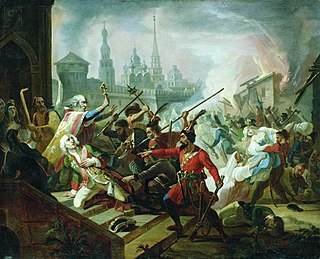
The Mongol Empire invaded and conquered much of Kievan Rus' in the mid-13th century, sacking numerous cities such as Ryazan, Yaroslavl, Pereyaslavl and Vladimir, including the largest: Kiev and Chernigov. The siege of Kiev in 1240 by the Mongols is generally held to mark the end of the state of Kievan Rus', which had already been undergoing fragmentation. Many other principalities and urban centres in the northwest and southwest escaped complete destruction or suffered little to no damage from the Mongol invasion, including Galicia–Volhynia, Pskov, Smolensk, Polotsk, Vitebsk, and probably Rostov and Uglich.

"Tatar" is an umbrella term for different Turkic ethnic groups bearing the name "Tatar" across Eastern Europe and Asia.

Kazan is the largest city and capital of Tatarstan, Russia. The city lies at the confluence of the Volga and the Kazanka Rivers, covering an area of 425.3 square kilometres, with a population of over 1.3 million residents, and up to nearly 2 million residents in the greater metropolitan area. Kazan is the fifth-largest city in Russia, being the most populous city on the Volga, as well as within the Volga Federal District.

Volga Bulgaria or Volga–Kama Bulgaria was a historical Bulgar state that existed between the 9th and 13th centuries around the confluence of the Volga and Kama River, in what is now European Russia. Volga Bulgaria was a multi-ethnic state with large numbers of Bulgars, Finno-Ugrians, Varangians, and East Slavs. Its strategic position allowed it to create a local trade monopoly with Norse, Cumans, and Pannonian Avars.

The Khanate of Kazan was a Tatar state that occupied the territory of the former Volga Bulgaria between 1438 and 1552. The khanate covered contemporary Tatarstan, Mari El, Chuvashia, Mordovia, and parts of Udmurtia and Bashkortostan; its capital was the city of Kazan. It was one of the successor states of the Golden Horde (Mongol state), and it came to an end when it was conquered by the Tsardom of Russia.

Bolghar was intermittently the capital of Volga Bulgaria from the 10th to the 13th centuries, along with Bilyar and Nur-Suvar. It was situated on the bank of the Volga River, about 30 km downstream from its confluence with the Kama River and some 130 km from modern Kazan in what is now Spassky District. West of it lies a small modern town, since 1991 known as Bolgar. The UNESCO World Heritage Committee inscribed Bolgar Historical and Archaeological Complex to the World Heritage List in 2014.
Bilär - was a medieval city in Volga Bulgaria and its second capital before the Mongol invasion of Volga Bulgaria. It was located on the left bank of the Small Cheremshan River in Alexeeyevsky District of the Tatarstan. The distance to Bilyarsk is 50 km and 150 km to Kazan.
İske Qazan, was a Bolghar-Tatar city in the 13-16th centuries, situated on the banks of the Kazanka River in the Kazan artı or Zakazanye region, in what is today the Russian Federation republic of Tatarstan.
The Mongol invasion of Volga Bulgaria lasted from 1223 to 1236. The Bulgar state, centered in lower Volga and Kama, was the center of the fur trade in Eurasia throughout most of its history. Before the Mongol conquest, Russians of Novgorod and Vladimir repeatedly looted and attacked the area, thereby weakening the Bulgar state's economy and military power. The latter ambushed the Mongols in the later 1223 or in 1224. Several clashes occurred between 1229–1234, and the Mongol Empire conquered the Bulgars in 1236.

The territory of Tatarstan, a republic of the Russian Federation, was inhabited by different groups during the prehistoric period. The state of Volga Bulgaria grew during the Middle Ages and for a time was subject to the Khazars. The Volga Bulgars became Muslim and incorporated various Turkic peoples to form the modern Volga Tatar ethnic group.

Zilant is a legendary creature, something between a dragon and a wyvern in Turkic mythology. Since 1730, it has been the official symbol of Kazan. This winged snake is mentioned in legends about the foundation of Kazan.

The Volga Tatars or simply Tatars are a Turkic ethnic group native to the Volga-Ural region of western Russia. They are subdivided into various subgroups. Volga Tatars are the second-largest ethnic group in Russia after ethnic Russians. Most of them live in the republics of Tatarstan and Bashkortostan. Their native language is Tatar, a language of the Turkic language family. The predominant religion is Sunni Islam, followed by Orthodox Christianity.

The Russo-Kazan Wars were a series of short, intermittent wars fought between the Grand Principality of Moscow and the Khanate of Kazan between 1437 and 1556. Most of these were wars of succession in Kazan, in which Muscovy intervened on behalf of the dynastic interests of its main ally, the Crimean Khanate. For most of the period, neither side sought to conquer the other, until Ivan the Terrible decided to annex Kazan upon the successful 1552 siege, which was followed by a rebellion lasting until 1556.

The siege of Kazan or Fall of Kazan in 1552 was the final battle of the Russo-Kazan Wars and led to the fall of the Khanate of Kazan. Conflict continued after the fall of Kazan, however, as rebel governments formed in Çalım and Mişätamaq, and a new khan was invited from the Nogais. This guerrilla war lingered until 1556.

The Battle of Kazan (1774) was a major battle during Pugachev's Rebellion. It took place on 12–15 July 1774 in Kazan, Russia, and the surrounding area. The first stage began in the morning of 12 July, when rebels under Yemelyan Pugachev defeated government troops and besieged them in the Kazan Kremlin. During the battle some government forces defected to the rebels' side. However, in the evening, tsarist forces under Johann Michelson reached Kazan and defeated the rebels in two battles which took place on 13 and 15 July, forcing Pugachev to retreat to Tsaryovokokshaysk and then to cross the Volga. Out of 25,000 and 15,000 rebels who participated in the first and last stages of the battle respectively, only 500 escaped.
The Battle of Samara Bend, also known as the Battle of Kernek, was the first battle between the Volga Bulgaria and the Mongol Empire, which took place during the autumn of 1223 at the southern border of Volga Bulgaria. It is famous for being the first battle that the Mongol Horde lost. The battle began with the Bulgar forces retreating and the Mongols pursuing them, leading them successfully into a Bulgar ambush. The Bulgars counterattacked the Mongols, and drove them back.
Ashli or Aşlı was a mysterious medieval Volga Bulgarian town. In Russian chronicles it is known as Oshel.

Kryashens are a sub-group of the Volga Tatars, frequently referred to as one of the minority ethnic groups in Russia. They are mostly found in Tatarstan and in Udmurtia, Bashkortostan and Chelyabinsk Oblast.

Tetyushsky District is a territorial administrative unit and municipal district of the Republic of Tatarstan within the Russian Federation. The district is located in the south-west of Tatarstan, on the right bank of the Kuybyshev Reservoir, and shares borders with the Ulyanovsk Oblast, Buinsky, Apastovsky and Kamsko-Ustyinsky District. The administrative center of the district is the city of Tetyushi.













